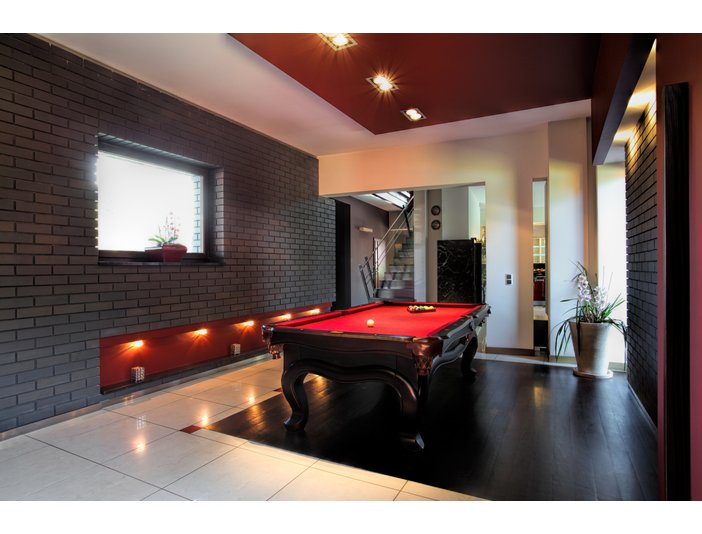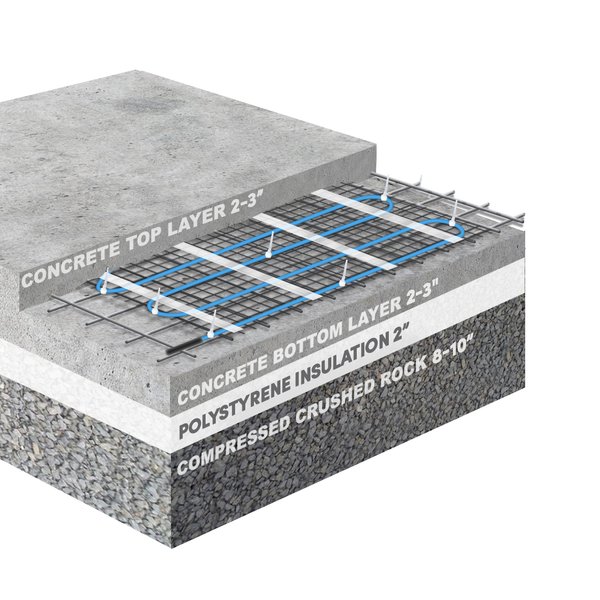How To Install Radiant Heat On Concrete Slab
Cheers to concrete, residential and commercial properties around the world are safely supported. However, the same concrete that brings structure to a building is often responsible for creating a cold, clammy living environment. For a homeowner, this often means that a basement is not utilized to its full potential. It might be used for storage instead of offer an additional level of living space for a family unit.
To warm upwards a basement, y'all could install carpet to help insulate the space. Withal, that won't heat upward the area. Instead, you should turn to electrical flooring heating to warm upwardly that cold concrete slab.
In the United states, yous can heat nether carpet using a flooring-warming roll or mat made from reinforced, laminated aluminum foil with cable spaced two inches apart. Withal, many people plough to pop tile, stone and vinyl floor options with electric floor heating installed underneath. These materials would typically add to the cold feeling of a basement, but with electric radiant heat, they offer an upscale way to warm up a room.
Warm Floor, Warm Basement
According to a bobvila.com commodity, ceramic tile is "the Cadillac of basement flooring," because it is unaffected past water or water vapor, which can ofttimes enter the basement through the physical. Too, glue-downwards vinyl tiles or planks are water resistant, which is ideal in a basement.
When you call up of vinyl flooring, you might pic vinyl tiles from the 70s, featuring bright geometric patterns. Today, there is a new brood of vinyl called luxury vinyl tile or LVT.

"Today's products can emulate the wait of wood, ceramic or rock rather assuredly," states the bobvila.com article.
Whether you lot decide to install tile, stone or vinyl, y'all know your flooring volition be safe from potential h2o damage. Only, if you lot install radiant floor heating on height of the slab and underneath the flooring surface, how can you ensure that the heating chemical element is protected? Enter underlayment.
Radiant Floor Heating Concrete Slab Insulation
CeraZorb® is a 3/16-inch (5-mm) thin synthetic cork underlayment that is highly recommended when installing a floor heating system over an existing physical slab or nether tile and stone. CeraZorb® acts as a wet-resistant barrier that does not absorb water or nifty under the effects of estrus or cold weather. The synthetic cork underlayment will not rot and is impervious to mold and mildew. That ways your electrical heating element will be protected from whatever potential water leakage from the concrete.
When CeraZorb® is used in conjunction with our TempZone™ electrical radiant floor-heating arrangement, the underlayment also enhances heat and sound insulation and increases proper heat distribution that results in cost effective performance. Plus, the underlayment helps to forestall cracks in the flooring surface, which is especially important with tile and stone.
CeraZorb® was besides designed to exist easy to install. It comes in 4- by ii-pes sheets and then that it will install flat against the physical, without any crimper or memory, equally you would get with rolls of insulation.
How to Install Radiant Flooring Heating in Physical
For new-construction homes, there is yet another way to heat upward a cold slab, and it starts earlier the concrete has even hardened.
Slab heating mats and cables can be installed directly in the concrete when information technology is beingness poured. Offering 20 watts per square foot, the slab estrus mats are platonic if y'all'd like physical to be the final floor surface. In a basement, you might employ trendy terminate floor like stamped, polished or stained physical floors with radiant rut installed within.

Hither are the steps for installing slab heating cables or mats:
Stride 1:
Pull out your custom installation plan and identify where the thermostat should exist placed. The get-go affair your electrician should do is install the thermostat and its junction box equally well as any relay panels, if necessary. Your electrician can decide which electrical rough-in kit is advisable for your home.
Footstep 2:
Using a digital ohmmeter, test the heating element's ohm value between the two conductors (yellowish and blackness for 120V, ruddy and black for 240V systems) and verify that value with the value on the product's CSA tag. Also, exam the heating element with a megaohmmeter betwixt each usher and the yellow/light-green basis wire, ane at a fourth dimension. The 500 VDC megaohmmeter tests for insulation resistance between the conductors and the ground and should read space, or OL.
Step iii:
The concrete installer should spread and tamp downwardly at least 8 to 12 inches of crushed rock aggregate. On top of that, 2-inch polystyrene insulation (or better) must be installed. This insulation should also be placed vertically effectually the perimeter of the slab to prevent heat loss from the edges. Finally, heavy-guess wire mesh or rebar should be used for reinforcement. Wire chairs or concrete pavers can be used to prop up the wire mesh or rebar.
Step four:
Using plastic cablevision ties, the electrician should attach the temperature sensor and heating cable/mat to the wire mesh per your custom installation programme, being certain to avoid whatever overlapping, touching or crossing of heating wires. Install the sensor at the same depth and midway between the ii heating wires. Once this is washed, the heating cable and sensor should be tested with an ohmmeter and then inserted into a metal or other canonical conduit that goes from the flooring to the junction box in the wall. The sensor wire should be run to the controller in a split conduit from the heating wire cold leads. Never run the sensor wire adjacent to, or above or beneath, a heating wire.

Footstep v:
Now that the heating element and sensor are installed, the concrete installer can finish pouring the slab. The installer should pour iv to 6 inches of physical to bury the heating chemical element, leaving information technology 2 to 3 inches beneath the finished concrete surface. Continue to test the cable with an ohmmeter during the cascade.
Stride half-dozen:
The electrician should test the heating element and sensor with an ohmmeter and megaohmmeter 1 more time. Exist certain to enter the results on your warranty documents.
Stride 7:
Once the concrete has fully cured, the electrician tin consummate all of the wiring for the thermostat, junction box and relay panel, if needed. Breakers should be turned on, and the organization should exist activated to let the electrician to check the amp depict of the heating element. If everything is in working order, you're done!
For total installation instructions, please consult WarmlyYours's Slab Heating Installation Manual. Additionally, if you have whatsoever questions or bug during installation, feel gratuitous to give the WarmlyYours technical back up team a phone call. They are available 24/7 at 800-875-5285 for your convenience.
Delight annotation that if you'd like to install some other floor covering over the concrete, however, yous should embed slab heating cable spaced 5 inches apart within a freshly poured concrete slab. The lower watt density of this cable allows you to add together a floor covering of your choice installed on top of the physical. The do good of heating on a slab with cable is that the flooring can be removed or replaced at whatever fourth dimension without impacting the radiant rut. If you installed tile over TempZone™ radiant oestrus in a bathroom, for example, and you wanted to replace the tile, yous would demand to tear out the radiant heating every bit well considering it's adhered to the tile with thinset.
However you choose to heat your slab, the addition of radiant heating will turn your space into a comfortable retreat all yr round.
Curious virtually heated concrete floor price? Use our Radiant Floor Heating Quote Builder to become an instant judge for how much a floor heating system would cost for your ain project.
Source: https://www.warmlyyours.com/en-US/posts/how-to-install-radiant-heat-in-a-concrete-floor
Posted by: harbinforrounce.blogspot.com


0 Response to "How To Install Radiant Heat On Concrete Slab"
Post a Comment